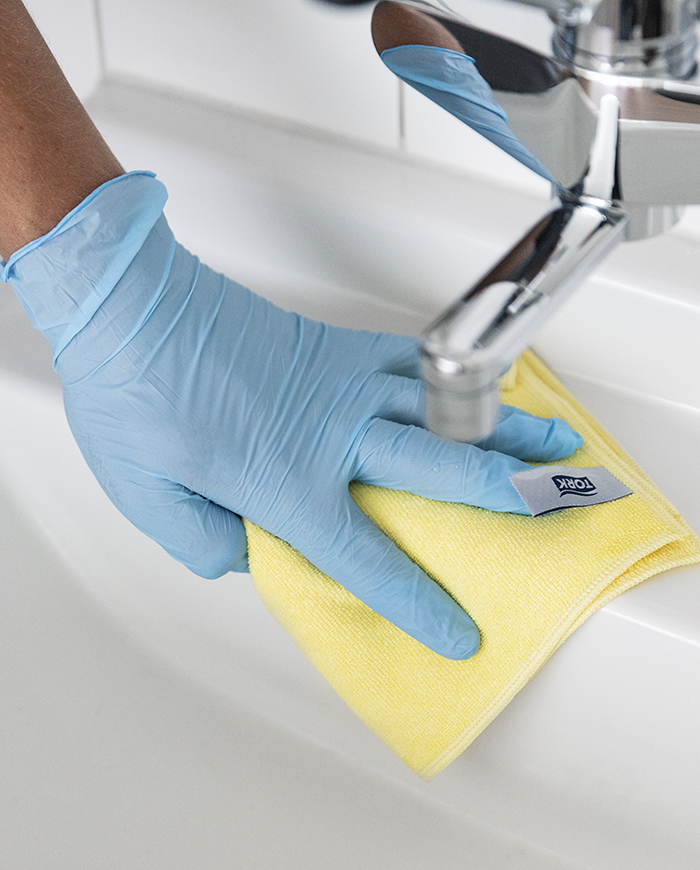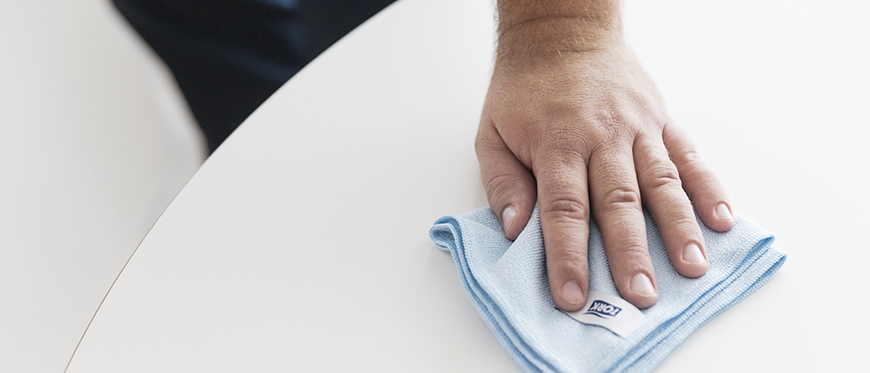The importance of cleaning and disinfecting surfaces to reduce the spread of colds, the flu, and the COVID-19 virus is well known. Understanding the science, though, can help you choose the most effective cleaning products and methods.
For example, the structure of microfibers makes it one of the most effective tools for removing bacteria, viruses, and other pathogens from surfaces. Learn about the characteristics of microorganisms and unique qualities of microfiber cleaning cloths below.
A mini-microbe lesson
As the term suggests, microorganisms are tiny creatures. Individual microorganisms are invisible to the naked eye, although we can see large numbers of them together as they grow, as in the case of mold on bread. Other examples of microorganisms include yeast, bacteria, and viruses.
While it’s easy to lump all “germs” together, they are very genetically diverse. Interestingly, yeast cells and humans are more closely related to each other than bacteria and yeast cells. Each multiplies in different ways. For example, bacteria grow by cell division, while a virus infects another living cell and uses it to create copies of itself. Understanding the different properties of microorganisms can help you choose the most effective cleaning procedures and materials.
All about bacteria

One of the most common microorganisms, bacteria cells tend to be only 2 micrometers long and exist in a variety of shapes, such as rods, spirals, and spheres. Their various characteristics help them thrive in different environments. Some survive in high temperatures, while others prefer cooler surroundings. Their lifespan varies too—some live a few hours; others can survive 46 months in the right conditions.
Our bodies and surroundings host a flourishing population of bacteria, some of which are “good” and contribute to our health, such as gut microflora. Others are “bad” and can cause us to fall ill. Reducing the number of “bad” bacteria on surfaces is one way to prevent disease and the transmission from one person to another.
Identifying the highest-priority places to clean is made easier when you know where bacteria like to hide and grow. Typically, they like wet surfaces. Those provide the right conditions for bacteria to form a slimy layer called a biofilm that makes it harder to remove and kill them. Biofilms can develop on sinks, tubs, and countertops. Shining a UV light can reveal buildups of bacteria. Swabbing surfaces and analyzing them for proteins or DNA takes longer but can help pin down specific strains.
Microbes to watch out for in hospitals
Eliminating disease-causing microorganisms in hospitals and other healthcare environments is a critical mission. A few of the microorganisms that are of particular concern in healthcare facilities include:
- MRSA, a staphylococcus bacterium often associated with skin infections and post-surgical complications.
- Clostridium difficile, a spore bacterium that can cause chronic and even life-threatening inflammation of the colon.
- Norovirus, which causes vomiting and diarrhea. It takes just a few particles to infect humans and can survive for weeks on hard surfaces, making it incredibly easy to spread.
- Coronaviruses, which have gained notoriety from the COVID-19 pandemic but also cause the common cold. Other severe coronaviruses include SARS and MERS. Unlike Norovirus, coronaviruses have a fatty “envelope” that makes them more susceptible to disinfectants, sanitizers, and cleaning with detergents and water at high temperatures.
Unfortunately, some pathogens have evolved to develop resistance to commonly used disinfectants and antibiotics. The latter poses a special threat to public health around the world as certain infections—including common ones like pneumonia–become harder to treat.
Why microfiber cloths are so good at eliminating microorganisms
As the name suggests, microfiber is very thin — hundreds of times finer than human hair. Microfiber is often used for cleaning products like wipes and mops. The most effective microfibers for cleaning purposes consist of a blend of polyester and polyamide polymers, which are “split” chemically, thermally, or mechanically to make very fine fibers. The smaller the fibers — some are even smaller than microorganisms — the greater the ability to pick up and trap bacteria, viruses, and mold rather than just push it around.
The number of fibers per square inch in a woven textile has implications for cleaning efficacy and durability as well. In short, more is better. High-fiber microfiber clothes can withstand 300 washings or more. In addition, polyamide has absorbent qualities, so even cloths dampened only with water can be very effective at cleaning.
All of these qualities make microfibers a better choice for cleaning cloths than cotton. In fact, microfiber has been proven to remove up to 98 percent of bacteria and 93 percent of viruses from a surface using only water. Compare that to cotton fibers, which only remove 30 percent of bacteria and 23 percent of viruses.1 Microfibers are more absorbent than cotton and dry faster, further preventing the growth of microorganisms.
The meaning of microfiber cloth colors

Color-coding microfiber cleaning cloths indicates uses for different areas. While not every region of the world follows this system, it’s a helpful practice that can promote safety and prevent cross-contamination among cleaning supplies. Tork offers four different colors of reusable microfiber cleaning cloths, so you can apply this method to support surface hygiene.
- Red: for high-risk areas like toilets and urinals
- Blue: for lower-risk areas such as offices and conference rooms
- Green: for bars, kitchens, and other areas where food is cooked, processed, and served
- Yellow: for surface areas in restrooms such as sinks, cabinets, and mirrors
Ensure your cleaning methods are effective
Microfiber cleaning cloths can be a highly effective tool in your healthcare facility’s strategy for eliminating disease-causing microorganisms and keeping patients safe. Knowing how to use them correctly is another key piece. Ready to learn how to properly clean surfaces with microfibers? Click here to learn more.
Sources
1 Infection Control Today: Understanding Microfiber’s Role in Infection Prevention
